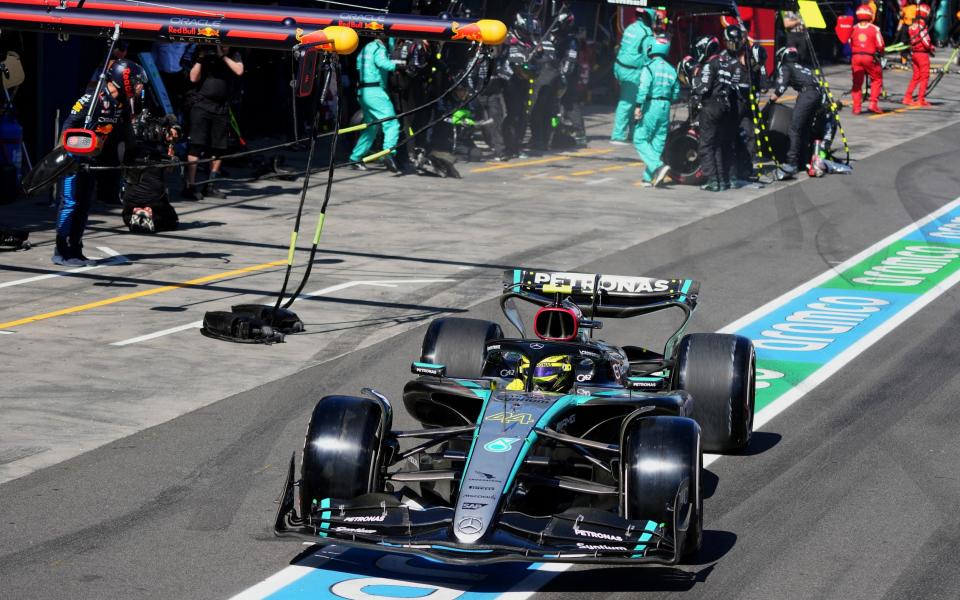Lewis Hamilton suffers worst start to a season – and Mercedes still do not know why

This season was meant to be a fresh start for Mercedes. After a dire 2022 and an equally disappointing 2023, a “fundamental change” in the philosophy of their new car had led to hopes over the winter that they had finally got on top of the issues which have held them back in this ground-effect era. The ‘zeropods’ were gone, the floor was revised, the real-world telemetry appeared to back up what they were seeing in the simulator.
How dispiriting, then, that after three races not only are Mercedes in a worse position than before, relative to their rivals, with the fifth fastest car on single-lap pace, but that their biggest problem of all has returned. Namely, they do not understand what is causing their wildly fluctuating performances. Mercedes go from being a tenth of a second off the pace in one session, to a second off the pace in another. And they do not have a clue why.
As Toto Wolff admitted an hour or two after the finish in Melbourne on Sunday: “We don’t understand some of the behaviours of the car. What we see in the [wind] tunnel doesn’t correlate to what we see out on the track. There were times in the race where we massively lacked pace and then there were times when we were doing OK.
“On one side, I want to punch myself on the nose. But on the other side you can see that if you get things right you can turn it around. So you have to believe. But it is a very, very tough time.”
"Engine failure, engine failure" 📻
A nightmare end to Lewis Hamilton's Australian Grand Prix 😲 pic.twitter.com/akWYM2pIhX— Sky Sports F1 (@SkySportsF1) March 24, 2024
Wolff was in commendably introspective form during his 20-minute media session. The Austrian acknowledged how frustrating the situation was. He admitted he was at a loss to explain the inconsistency that Lewis Hamilton warned on Saturday was beginning to “mess with his mind”. He even accepted it was fair to ask whether he was the right man to lead Mercedes out of the quagmire.
But ultimately, such ‘openness and transparency’ (to use a phrase Wolff himself has deployed liberally this season, mostly in relation to the dramas at Red Bull and the FIA) will not make the W15 any faster. Understanding what is causing it to go fast one minute and slow the next, will.
In that respect, Mercedes appear to be in serious trouble. They thought they had their baseline this season. They always knew they would be off the pace of Red Bull at the start of the year. But the key objective was to have a car that worked consistently and performed in line with what the team expected.
After this weekend, there is no getting away from the fact that Mercedes appear to be lost again. Hamilton complained after qualifying on Saturday of a car that was “on a knife edge” in terms of its sweet spot. When you are in that sweet spot, he said, the W15 is quick. Arguably as quick as the Ferrari. The trouble is they do not know how to get in it consistently.
This is now officially Hamilton’s worst ever start to a Formula One season. Even before he retired from the Australian race he was running ninth. He has now gone 9th, 7th and DNF in his three races so far this year. His previous worst was 2009 when he started DSQ, 7th, 6th.
His decision to defect to Ferrari next year is beginning to look less like a gamble that they will be the better bet going forwards, and more like he suspected something was fundamentally broken at Brackley and they did not know how to fix it.
“Surprisingly I feel pretty good,” Hamilton claimed after this race. “I’m trying to keep things in perspective because they could be so much worse. It’s not great. I’m not happy. But I’m going to have a great day tomorrow.” Maybe that is because, as Wolff also conceded, Hamilton can “look over the fence” at Ferrari and imagine where he will be in a year’s time. At a team who are beginning to look as if they have got their act together.
For Mercedes, the misery continues. As Wolff noted: “We started this season in the belief that this car was better than last year’s, and then you look at [the Australian race] last year and Leclerc crashed out and Sainz was fourth and McLaren were 17th, 18th. This year they were 40 seconds ahead of us.”
Can they turn it around? That remains to be seen. “I don’t see dogmatism,” Wolff insisted. “I see an open environment where people share and take themselves by the nose. [But] everything I have done before, in finance and investment, you know which screws to turn and you know sometimes it takes time. Here, I don’t think we are missing things. It is just a complication that is happening with the car that we cannot see, and it is like an on-off switch. It is brutally painful.”

